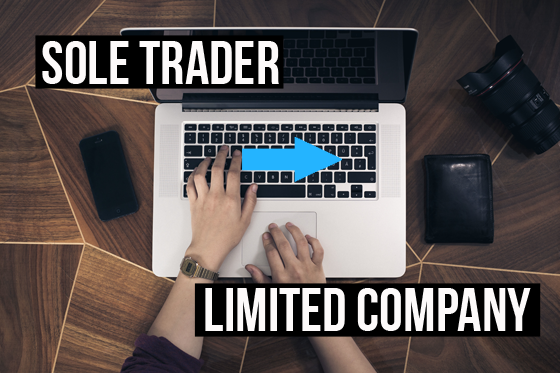As a sole trader considering the transition to a limited company, the most common deterrent usually has something to do with the cost. Sole traders are in charge of their own accounts and Self Assessment returns and often incorrectly assume that as a limited company, the costs for these services would be too high.

More about being a Sole Trader
Self-employed workers and freelancers are automatically classified as sole traders, even before reporting to HMRC, though it is important that they register.
As a sole trader, you’re responsible for managing all aspects of your business, including tax, profits, etc. You’re personally responsible for any losses, but you are also entitled to all profits after the appropriate tax has been paid.
While a sole trader runs and manages their own business and accounts, this does not mean that they must work alone. A sole trader can also employ staff to help out in the business as long as they adhere to the guidelines set out by HMRC.
Forming a Limited Company
So what does it mean to become a limited company? The step from sole trader to incorporating your business is not as daunting as it may seem. By incorporating, your business becomes a limited company.
This means that your business is now run by an organisation, not by you personally. The organisation is responsible for the running of the business and essentially separates the business from your personal accounts.
Tax falls under the responsibility of the company, and any revenue that remains after payment of Corporation Tax belongs to the company.
How to register as a limited company
Today, the process for incorporating is a considerably simple process, and often takes less than 24 hours.
You can file directly with the Companies House for a fee of just £15. Here’s what you’ll need:
- The full registered name and address of your company
- The names and addresses of directors and the company secretary if applicable
- All details concerning shareholders and capital
There are several other options available to simplify this process that ensure you have provided all the necessary information for forming a limited company. These formation agents guide you through the process and often result in faster results. In many cases, using an agent will mean that your incorporation will go through in just a few hours.
The different types of incorporation
The most common are: Incorporation relief and Holdover relief. In many cases, incorporation relief is the most appropriate for sole traders making the transition, but as in any decision concerning your business, all options should be carefully considered.
Incorporation relief: This type of incorporation affects the tax rate of your business. Incorporation tax is automatically applied unless the business states that it should not, in writing.
A business must be valued at the open market value (including goodwill) before formation of the limited company before it can benefit from incorporation relief.
In order to claim incorporation relief, the three following conditions must be met:
- The business must be a going concern
- All assets except cash must be transferred to the limited company
- Shares must constitute the entirety or part of what is paid for the business assets
For example:
If a business is transferred in exchange for shares with a value of £50,000. The owner’s profit is £30,000. Later, the owner decides to sell the shares and must then figure out the gain. The cost for the Capital Gains Tax would be £20,000 (£50,000 - £30,000).
For more information, HMRC offers helpsheet HS276 to aid in these matters.
Holdover relief: this type of incorporation involves business assets that are transferred directly from an individual. This means that capital gains are not applicable right away, meaning that the Capital Gains Tax on the assets can be delayed.
For example:
A boutique owner sells their shop with a value of £71,000 to their sister for £38,000. The cost of purchase for the original owner was £26,000, so the £12,000 gain (the difference between £38,000 - £26,000) must be included when the total taxable gain is being determined.

Holdover relief can be useful to those who wish to hold property outside of the company and instead prefer to pay rent for the property. This method does provide certain tax advantages.
However, it classifies the property as an investment property, meaning the owner would not be able to benefit from entrepreneur’s relief on the property.
Limited Company buying a Sole Trader business
As of December 2014, Entrepreneurs relief can no longer be applied to this type of transaction. However, there are several reasons this approach might still be an option worth consideration.
For example:
- Ms Jones has owned a graphic design business for a couple of years.
- She decides to incorporate the business under the name ‘Jones Design Ltd’ listing herself as the director and sole shareholder.
- She transfers all assets, goodwill, and liabilities to the limited company but chooses to forego Incorporation Relief under the Capital Gains Tax (CGT).
- Because the CGT exemption allowance for 2016/2017 is £11,100 and the goodwill value of Jones Design Ltd. is £10,000, Ms Jones decides to make a chargeable gain on the goodwill transfer.
- Credit is transferred to Ms Jones’ director loan account, where she can draw from it without further tax implications.
To incorporate or to remain a sole trader?
While the prospect of forming a limited company may seem daunting, hopefully this article has outlined that the process is not only straightforward but can provide financial flexibility and room for growth of the business.
As in any decisions concerning the future of your business, it is important to do your research and thoroughly consider the right steps for continued development that will help your company thrive.
